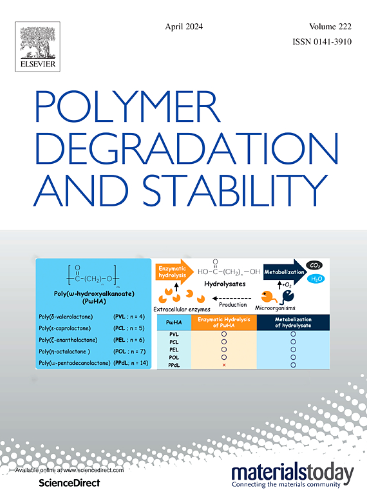Biobased bisbenzoxazine resins derived from sesamol and furfurylamine: Using natural renewable resources to access phosphorus- and halogen-free flame-retardant thermosets
IF 6.3
2区 化学
Q1 POLYMER SCIENCE
引用次数: 0
Abstract
Biomass derivatives are a promising class of precursors for developing natural sustainable polymers. However, biobased polymers generally possess flammable characteristic and poor thermal stability, which seriously restrain their further applications. Herein, two biobased diamines (PDFA and CPDFA) were successfully synthesized using furfurylamine and benzaldehyde/cyanobenzaldehyde as starting materials. In addition, two novel bio-bisbenzoxazine monomers, S-cpdfa and S-pdfa, were obtained via the Mannich condensation reaction from paraformaldehyde, sesamol and PDFA/CPDFA. The chemical structures of both biobased bisbenzoxazines have been confirmed by FT-IR, 1H NMR, 13C NMR, and 2D HMQC spectroscopies as well as high-resolution mass spectrometry (HR-MS). Moreover, the polymerization behaviors of bisbenzoxazine monomers were investigated by DSC and in situ FT-IR analyses. It is noteworthy that fully polymerized biobased thermosetting resins exhibit high thermal stability with Td10 of 373.8 °C and Yc of 63.2 % for poly(S-pdfa), and Td10 of 395.4 °C and Yc of 65.7 % for poly(S-cpdfa), respectively. Notably, poly(S-cpdfa) exhibited very low flammability and self-extinguishing performance as indicated by HRC of 13.1 J·g⁻¹·K⁻¹ and THR of 2.8 kJ·g⁻¹. This work presents a straightforward and environmentally conscious methodology to access phosphorus- and halogen-free thermosets with intrinsically flame retardancy using natural renewable resources.
求助全文
约1分钟内获得全文
求助全文
来源期刊

Polymer Degradation and Stability
化学-高分子科学
CiteScore
10.10
自引率
10.20%
发文量
325
审稿时长
23 days
期刊介绍:
Polymer Degradation and Stability deals with the degradation reactions and their control which are a major preoccupation of practitioners of the many and diverse aspects of modern polymer technology.
Deteriorative reactions occur during processing, when polymers are subjected to heat, oxygen and mechanical stress, and during the useful life of the materials when oxygen and sunlight are the most important degradative agencies. In more specialised applications, degradation may be induced by high energy radiation, ozone, atmospheric pollutants, mechanical stress, biological action, hydrolysis and many other influences. The mechanisms of these reactions and stabilisation processes must be understood if the technology and application of polymers are to continue to advance. The reporting of investigations of this kind is therefore a major function of this journal.
However there are also new developments in polymer technology in which degradation processes find positive applications. For example, photodegradable plastics are now available, the recycling of polymeric products will become increasingly important, degradation and combustion studies are involved in the definition of the fire hazards which are associated with polymeric materials and the microelectronics industry is vitally dependent upon polymer degradation in the manufacture of its circuitry. Polymer properties may also be improved by processes like curing and grafting, the chemistry of which can be closely related to that which causes physical deterioration in other circumstances.
 求助内容:
求助内容: 应助结果提醒方式:
应助结果提醒方式:


